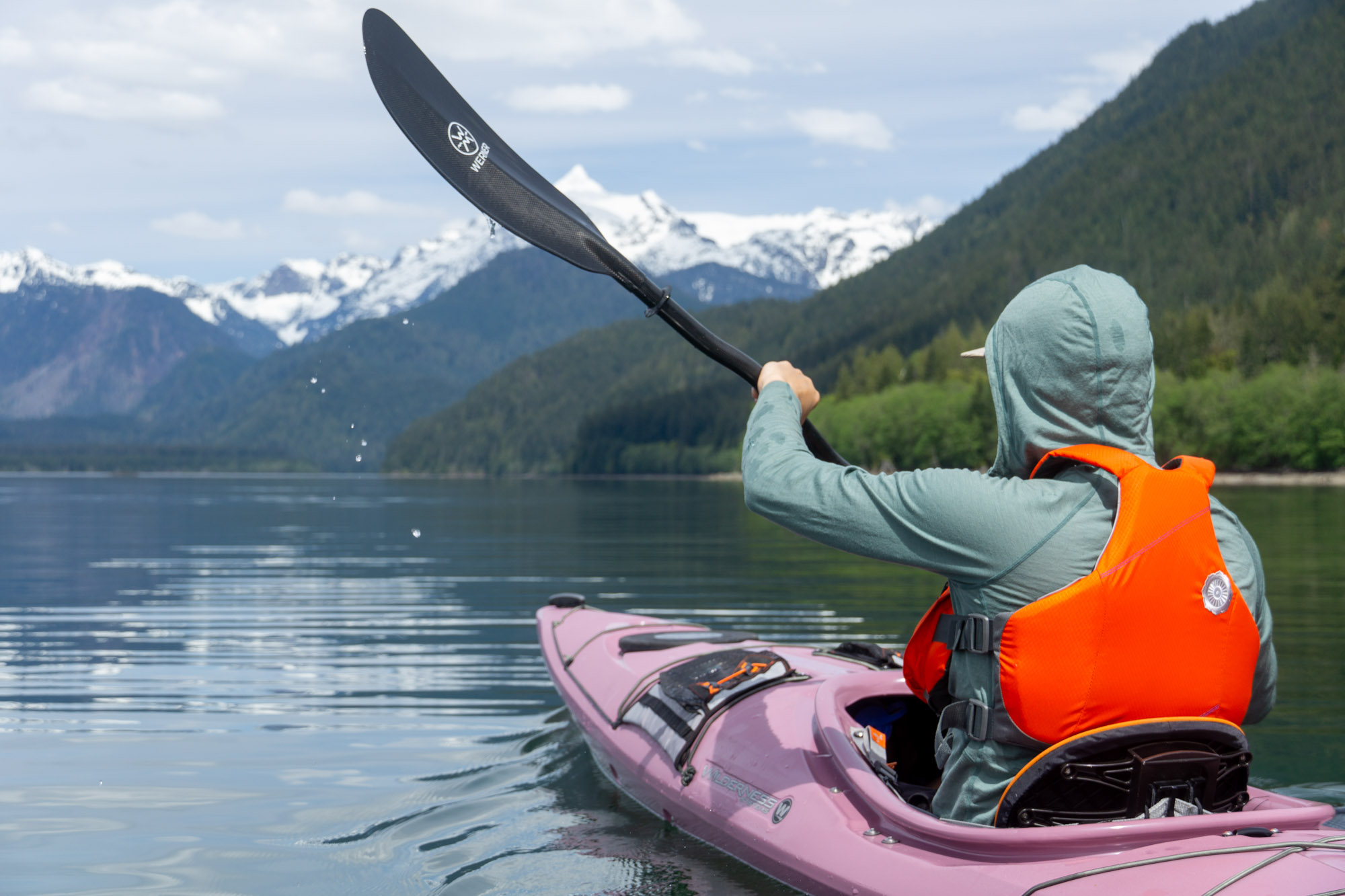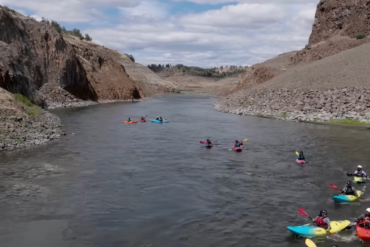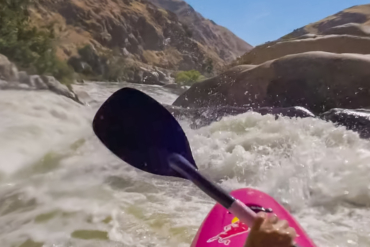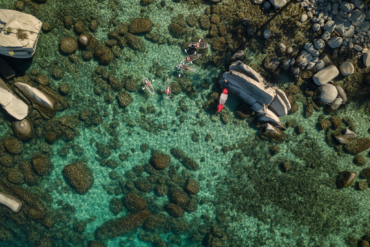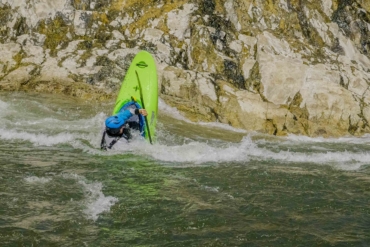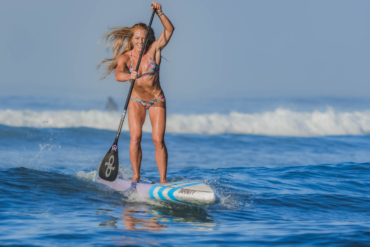A good kayak paddle is essential for getting out in the water, and without one, well, you’ll be up the creek. We’ve paddled with plenty of them, and through years of casual and strict comparison alike, we’ve settled on the quiver of the best kayak paddles we’d take anywhere.
No one ever paddles the same river twice, and with kayaks ranging from sea-worthy expedition shells to plunk-around rec boats, using a paddle that is primed for the style of paddling you’re after is key to getting the most out of your kayak. From top picks like the Werner Shuna to casual and wallet-friendly options like the Carlisle Magic Plus, we think there’s something here for everyone.
Our experts consist of sea kayak and whitewater guides, packrafters, and even a few SUP tourers thrown in for good measure, and we used and abused these paddles over the course of many miles to figure out what makes them tick. We played with different lengths, feather angles, and blade profiles, and along the way, we formed a pretty good idea of what makes a kayak paddle great. Check out our top choices.
Editor’s Note: We updated our Kayak Paddles guide on November 20, 2024, to add our new favorite whitewater paddle, the Werner Powerhouse, and a new Price & Value section.
The Best Kayak Paddles of 2025
Werner Shuna
- Style: High-angle
- Shaft Material: Carbon
- Blade Material: Fiberglass laminate
- Blade Shape: Mid-sized, asymmetrical, dihedral face
- Ferrule: Smart View Adjustable; 60 degrees in either direction
- Lengths: 205, 210, 220, 230 cm
- Weight: 1 lb., 11.7 oz.
Pros
- All-around design works for different paddling situations and water
- Carbon shaft is available in standard and small diameters
- Smart View Adjustable ferrule is excellent, very low profile
- Blade reinforcement spine is strong and flattened for hydrodynamics
Cons
- Fiberglass blades will start to accumulate marks, flex a bit under load
- High angle design won't be for everyone
Carlisle Magic Plus
- Style: Low-angle
- Shaft Material: Wrapped fiberglass
- Blade Material: Fiberglass reinforced polypropylene
- Blade Shape: Mid-sized, asymmetrical
- Ferrule: Push-button; 0 and 60 degrees in either direction
- Lengths: 220, 230, 240, 250 cm
- Weight: 2 lbs., 7.8 oz.
Pros
- Budget pricing
- Fiberglass shaft is textured and ovalized for grip, much nicer than an aluminum shaft
- Glass-reinforced blades are stiffer than all plastic blades
- Longer lengths for recreational paddling
Cons
- Hefty at over 2 pounds
- Push button ferrule isn't the most robust, had some slop in the fit
Werner Kalliste Bent Shaft
- Style: Low-angle
- Shaft Material: Carbon
- Blade Material: Carbon with Dynel reinforced edges
- Blade Shape: Mid-sized, asymmetrical, dihedral face
- Ferrule: Smart View Adjustable; 60 degrees in either direction
- Lengths: 220, 230, 240 cm
- Weight: 1 lb., 9.2 oz.
Pros
- Bent carbon shaft is supremely stiff and reduces wrist fatigue
- Smooth back blade face makes for clean entry
- Smart View ferrule makes adjusting angle easy, and feels like a one piece paddle
- Dynel reinforcement on the blade edges reduces likelihood of chipping
Cons
- Bit bulky to store on deck of kayak
- High cost of entry
Aqua Bound Sting Ray Hybrid Posi-Lok
- Style: Low-angle
- Shaft Material: Carbon
- Blade Material: Fiberglass reinforced nylon
- Blade Shape: Mid-sized, asymmetrical, dihedral face
- Ferrule: Posi-Lok; 60 degrees in either direction
- Lengths: 200-260 cm in 5 cm increments
- Weight: 1 lb., 14 oz.
Pros
- Excellent value for the ability
- Posi-Lok ferrule is highly adjustable and strong
- Lightweight carbon shaft keeps overall bulk down
- Strong dihedral face splits water well, no flutter noted
- Wide available variety of lengths
Cons
- Nylon blades flex a bit under strong paddling
- Blade volume is fairly low, and won't move a lot of water if you need to
Werner Powerhouse
- Style: High-angle
- Shaft Material: Fiberglass
- Blade Material: Fiberglass laminate
- Blade Shape: High-volume, asymmetrical, dihedral face
- Ferrule: Fixed; R45/0/L45 or R30/L30
- Lengths: 194, 197, 200, 203, 206 cm
- Weight: 2 lbs., 3.2 oz.
Pros
- Exceptional durability and longevity
- Powerful blade design for maximum control
- Comfortable and intuitive to use
- Proven reliability in tough conditions
Cons
- Not the highest performing paddle on the market; carbon paddles are coming to dominate the market
- Cumbersome to transport due to one-piece construction
- Not the lightest WW model on the market
Aqua Bound Shred Carbon 4-Piece
- Style: High-angle
- Shaft Material: Carbon
- Blade Material: Carbon reinforced nylon
- Blade Shape: High-volume, asymmetrical, dihedral face
- Ferrule: Push-button, fixed angles of 0, 15, 30, 45, 60 degrees in either direction
- Lengths: 191, 194, 197, 200, 203 cm
- Weight: 2 lbs., 2.5 oz.
Pros
- Four piece design fits into packs or kayaks well
- Rugged carbon shaft
- Short lengths appropriate for whitewater paddling
- Large blade volume really moves water
- Affordable for a WW paddle
Cons
- Nylon ferrule shafts aren't the most tight
- Not true carbon blades
- Feather angle is fixed
NRS Ripple
- Style: High-angle
- Shaft Material: Fiberglass
- Blade Material: Fiberglass reinforced ABS
- Blade Shape: Mid-sized, asymmetrical
- Ferrule: Push-button, 0 or 45 degrees in either direction
- Lengths: 194, 197, 200, 210, 220, 230, 240 cm
- Weight: 2 lbs., 6 oz.
Pros
- Rugged glass-filled ABS blades are burly
- Built-in index grip on paddle shaft
- Available in a wide spread of lengths
- Blades move some good water
- Fiberglass shaft has a nice finish and grip
Cons
- Blade to shaft interface is with rivets
- Some flutter when paddled hard
Other Kayak Paddles That’ll Get You Down The Creek
- Style: Low-angle
- Shaft Material: 50% carbon/50% fiberglass
- Blade Material: Fiberglass composite
- Blade Shape: Low-volume, asymmetrical, dihedral face
- Ferrule: Leverlock; infinite angles
- Lengths: Fully adjustable between 220 and 240 cm
- Weight: 1 lb., 14 oz.
Pros
- Leverlock ferrule is adjustable in both length and angle
- Blades enter and exit water with ease
- Carbon/fiberglass blend shaft is strong and lightweight with full-carbon price
- Adjustable length is great for paddlers with multiple boats
Cons
- Comparatively pricey
- Blade design will wear and chip
- Ferrule design can become looser over time, need to be tightened
- Style: High-angle
- Shaft material: Fiberglass
- Blade material: Fiberglass
- Blade shape: Mid-size, asymmetrical, shallow dihedral face
- Ferrule: Push-button; R45/0/L45 or R30/L30
- Lengths: 194, 197, 200, 203, 206, 209 cm
- Weight: 2 lbs., 8.7 oz.
Pros
- Wide blade surface area catches and holds water
- Wide variety of feather angles available
- Reinforcement spine is tough and resists blade flex
- Custom-fit shaft sections fit tightly
- Fiberglass blades have light swing weight
Cons
- Steel push-button ferrule is durable, not not the highest performer
- Larger paddlers may need the bigger Powerhouse
- Style: Low-angle
- Shaft Material: Carbon and fiberglass blend
- Blade Material: Fiberglass reinforced nylon
- Blade Shape: Mid-sized, asymmetrical, dihedral face
- Ferrule: Smart View Adjustable; 60 degrees in either direction
- Lengths: 220, 230, 240, 250 cm
- Weight: 2 lbs., 1.7 oz.
Pros
- Great value for the performance
- Carbon and fiberglass shaft is a stiffer upgrade over similarly priced paddles
- Available in both standard and small diameter shafts
- Sharp blade dihedral tracks true
Cons
- Some deflection in the blades
- Costs a bit more than comparable paddles
- Style: Low-angle
- Shaft Material: Carbon
- Blade Material: Carbon and replaceable polyamide tips
- Blade Shape: Greenland-style
- Ferrule: Push-button 'Diamond Joint'; 0 angle adjustment
- Lengths: 210, 220, 230 cm
- Weight: 1 lb., 8.4 oz.
Pros
- Supreme ability in active sea swells, surf
- Polyamide tips take abuse, and can be replaced
- Small details like titanium hardware and carbon-spring push button
- Very lightweight
- Compact packed size
Cons
- Pricey bit of kit
- Steep learning curve to use effectively
- Style: Low-angle
- Shaft Material: Aluminum
- Blade Material: Polypropylene
- Blade Shape: Low-volume, asymmetric, no dihedral
- Ferrule: Push-button; 0 and 60 degrees in either direction
- Lengths: 210, 220, 230, 240 cm
- Weight: 2 lbs., 5 oz.
Pros
- Makes a great beginner or loaner paddle
- Budget pricing
- Strong blade to shaft interface
- Handmade in Wisconsin
- Aluminum shaft is strong and rigid, has rubberized grips
Cons
- Hefty at over 2 pounds
- Aluminum shaft is cold to the touch
- Blades can snap if bent too far
Kayak Paddle Comparison Chart
| Kayak Paddle | Price | Style | Shaft/Blade Material | Lengths | Weight |
|---|---|---|---|---|---|
| Werner Shuna | $335 | High-angle | Carbon, Fiberglass laminate | 205, 210, 220, 230 cm | 1 lb., 11.7 oz. |
| Carlisle Magic Plus | $125 | Low-angle | Wrapped fiberglass, Fiberglass reinforced polypropylene | 220, 230, 240, 250 cm | 2 lbs., 7.8 oz. |
| Werner Kalliste Bent Shaft | $550 | Low-angle | Carbon, Carbon with Dynel reinforced edges | 220, 230, 240 cm | 1 lb., 9.2 oz. |
| Aqua Bound Sting Ray Hybrid Posi-Lok | $180 | Low-angle | Carbon, Fiberglass reinforced nylon | 200-260 cm in 5 cm increments | 1 lb., 14 oz. |
| Werner Powerhouse | $308 | High-angle | Fiberglass, Fiberglass laminate | 194, 197, 200, 203, 206 cm | 2 lbs., 3.2 oz. |
| Aqua Bound Shred Carbon 4-Piece | $265 | High-angle | Carbon, Carbon reinforced nylon | 191, 194, 197, 200, 203 cm | 2 lbs., 2.5 oz. |
| NRS Ripple | $150 | High-angle | Fiberglass, Fiberglass reinforced ABS | 194, 197, 200, 210, 220, 230, 240 cm | 2 lbs., 6 oz. |
| Wilderness Systems Pungo Glass | $350 | Low-angle | 50% carbon/50% fiberglass, Fiberglass composite | Fully adjustable between 220 and 240 cm | 1 lb., 14 oz. |
| Werner Sherpa | $325 | High-angle | Fiberglass | 194, 197, 200, 203, 206, 209 cm | 2 lbs., 8.7 oz. |
| Werner Skagit FG | $174 | Low-angle | Carbon and fiberglass blend, Fiberglass reinforced nylon | 220, 230, 240, 250 cm | 2 lbs., 1.7 oz. |
| Gearlab Outdoors Kalleq | $468 | Low-angle | Carbon, Carbon and replaceable polyamide tips | 210, 220, 230 cm | 1 lb., 8.4 oz. |
| Bending Branches Whisper | $80 | Low-angle | Aluminum, Polypropylene | 210, 220, 230, 240 cm | 2 lbs., 5 oz. |
How We Tested the Best Kayak Paddles

Kayak paddles are your connection to the water you’re moving through — like an extension of your arms — and can be pretty personal so far as recreation equipment goes. Each behaves a bit differently while using, which often boils down to some pretty minute differences in angle, thickness, or material.
Our Expert Testers
A casual glance might conclude that most paddles are the same, but it’s all this we aimed to hone in on in our testing. Our testing team is well qualified for the job, too: Lead tester Nick Belcaster is a kayaker and packrafter out of Washington State, where he takes full advantage of the Cascade Range and the waters that flow from it. His testing for this guide saw him making a few multiday kayak trips in the Salish Sea, and paddling hard in rugged water in British Columbia.
Tester Wil Henkel brings a depth of experience to the team, with a history as both a sea kayak guide in the Pacific Northwest and a whitewater guide and teacher in Ecuador. He’s paddled everything from full-on touring shells to agile creek and play boats, and used just as many paddles. Wil handled our heavy water paddles for this review and gave them the proper blessing required before mashing on them.

Our Testing Process and Testing Grounds
Our testing was just as much structured as it was casual, with testing revolving around performance, ease of use, and value. We spent entire days in the lake passing paddles around, and focused intently on the entry, power phase, and exit of each stroke. Every paddle was used by both a seasoned vet and a beginner to gauge relative approachability, and each was set up and broken down scores of times to survey for wear.
And, to best understand the sport-specificity of these paddles, we used them to where they were most comfortable, and where they stood out like a sore thumb. This meant paddling fully loaded sea kayaks with whitewater paddles, using Greenland-style sticks in our canoes, and while we wouldn’t suggest paddling your bash-around creek boat with a $500+ full carbon touring scalpel, we did it so you don’t have to.
All of this testing gave us the best idea of what makes a paddle good at what it does, and shook out our list of the best available today. Our testing continues on a year-round basis, and as new paddles become available, we’ll loop them into the circuit to ensure our selection is as accurate as possible.
Buyer’s Guide: How to Choose a Kayak Paddle

While there are plenty of paddles on the market, nailing your purchase the first time is not only a great feeling but will provide you with the performance you’re after and complement your kayak. Besides a good PFD, a paddle is essential to getting out on the water.
There’s a surprising amount to consider baked into kayak paddles — from dihedral angles to power face volumes and entire textbooks on hydrodynamics that we won’t pretend to understand. We do, however, know a good paddle from a lackluster one, and the following should get you up to speed.
Types of Kayak Paddles
Before exploring anything else, you’ll need to determine the type of kayaking you’re looking to do with your paddle. Some paddles are versatile enough to be used for multiple styles of paddling, while others are hyper-focused and designed for a specific kind of paddling.
Recreational and Touring Paddles
The majority of paddles out there will fall into this category and are used for casual day boating or going a little deeper with your touring kayak. Typically longer to accommodate a shallower stroke angle, these paddles can be found between 205 and 260 cm and feature what are called Euro-style blades, which are roughly flower pedal-shaped and made for efficiency.
Recreational paddles are often constructed using fiberglass handles and nylon blades, though some choose the slightly nicer glass-reinforced blades for a bit more durability. Touring paddles need to be light for longer days of paddling, and they often use fiberglass or carbon shafts and blades to trim the weight.

Whitewater Paddles
Made for the splashy stuff, whitewater paddles are more about the power and ability to move water quickly. They are typically shorter — between 190 and 200 cm — as they need to be paddled quicker and deeper into the water than recreational paddles.
Whitewater paddles are also more durable, as they are more likely to be bashed into rocks or trees. High-end whitewater paddles are often all carbon fiber, which offers the greatest power transfer.
Paddle Performance

A paddle’s performance is a concert of several things, but it all comes down to the stroke — more specifically, the three components of the stroke: the catch, the pull, and the exit.
The catch is the initial part of the stroke where you place your blade in the water. Leading with your shoulder and pointing toward the bow, your paddle blade should enter the water with ease as you wind your body up. Here, a thin paddle edge makes for an easy entry.
As you begin to dig into the water, the pull is where your power is generated, and you’ll rotate your torso to lead the paddle through the stroke. During this phase is where something called flutter can occur, which is the blade twitching as it’s pulled from side to side in the water. This can be dealt with by angling your paddle slightly or using a paddle with more dihedral.
Finally, the exit is the withdrawal of the blade from the water, and winding up for another paddle stroke on the opposite side. This occurs about as the blade passes your hip, and you should aim to pluck the paddle up out of the water as you reset for another paddle.
Style of Paddling: Low- vs. High-Angle Blades

After reading up on some of the science, it’s time for a bit of the art. Paddling is comprised of a number of different strokes that move your paddle through the water, generating motion. The manner in which you make these strokes reflects greatly on how you move through the water, and one of the biggest differences lies between the high- and low-angle strokes.
The low-angle stroke is a more horizontal one, roughly between 20 and 30 degrees if you imagine your paddle shaft making the third side of a triangle between your body and the surface of the water. This stroke requires less effort and puts less stress on your joints, making it better for long-distance kayaking or leisurely paddles. The Werner Kalliste, Skagit FG, Aqua Bound Sting Ray, Wilderness Systems Pungo, and Bending Branches Whisper are all low-angle paddles.

A high-angle stroke places the blade more vertically in the water, and digs deeper to generate more power. This stoke is more energy-intensive, but muscles your kayak around quicker, making it ideal for rolling coastal waters or whitewater kayaking. The Werner Shuna, Sherpa, Powerhouse, Carlisle Magic Plus, Aqua Bound Shred, and NRS Ripple are all high-angle paddles.
Both of these strokes benefit from a differently shaped blade. Low-angle blades are typically longer, narrower, and mounted to longer paddle shafts. This allows them to enter the water more easily. The blades on high-angle paddles are wider than low-angle paddles, and have higher surface areas to catch and hold the water. Their paddle shafts are more often shorter, as they intersect the water closer to the hull of the kayak.
You’ll notice that most touring paddles sport a low-angle blade, and most whitewater paddles use a high-angle blade, though this is not always the case. Our favorite paddle for just about anything, the Werner Shuna, is a high-angle paddle meant for touring in water that might be more turbulent.
Feather Angle and Hand Control

Almost all kayak paddles allow for an adjustment known as feathering, which changes the angle between the two blades. This is done to best position the blades as they enter the water and eliminate the excessive wrist flexion required with a neutral-angled paddle, as well as reduce the wind resistance of the exposed paddle.
These adjustments are made possible by the paddle’s ferrule, which is the joining interface that can be set at different angles and locked in place. These ferrules can be of a few different designs, with the most basic being a push-button ferrule, which often offers only three different holes: 60 degrees in either direction and zero.
More advanced ferrules such as Werner’s Smart View Adjustable or Aqua Bound’s Posi-Lok ferrule offer up many more angles and locks solidly to provide single-piece-like performance. Which direction you feather your paddle will depend on your dominant hand, which will become the side you control the paddle from.
Deciding which feather angle to use, or even any angle at all, is highly personal, and we recommend trying out many to see how they feel. Most flatwater paddlers will use an angle between 45 and 60, while whitewater kayakers find a lower angle suits their deeper paddle strokes.
Blade and Shaft Design

Paddle Blades
The blades of your paddle are where the magic happens, and there’s quite a bit of hydrodynamics going on between every stroke. The power face is the side of your paddle that’s facing you while paddling, and it’s the one that is catching the water.
This face can often incorporate a dihedral shape, which is a bevel that adds a leading edge to the middle of the paddle to split the water. This is added to help prevent flutter, which occurs when a paddle is trying to turn sideways as it is drawn through the water. Typically, touring paddles will incorporate a higher degree of dihedral than whitewater paddles.
The shape of a paddle blade is also hugely important, and most kayak paddles will have an asymmetric shape — with a longer upper edge. This is done to push the paddle deeper into the stroke when it’s pulled through the water, and makes the paddle directional.
The length and width of a paddle can also change its characteristics, with low-angle paddles being longer and typically more narrow to more easily pass in and out of the water. Whitewater paddles are shorter and wider, to best concentrate the power face and push more water.
Finally, Greenland- or Aleutian-style paddles sport entirely different style blade profiles, and are elongated spars that spread their power face across a long cross section.

The volume of your paddle blade is an excellent metric for comparing the relative power between paddles, and most kayak paddles sport a 550-750 cm² blade volume. Low-angle touring paddles like the Wilderness Systems Pungo Glass (595 cm²) are on the lower end of the scale, as the slower cadence stroke used to paddle them doesn’t need to move as much water, and they typically paddle kayaks that don’t take much effort to keep moving.
The 615 cm² of the Werner Shuna is indicative of a mid-sized blade that is designed as an all-arounder, and can be paddled in a low- or high-angle stroke to make the best use of its surface area. Some paddles like the Shuna are offered with like-designs that are just enlarged for bigger paddlers, and the Werner Corryvreckan bumps up the volume to 721 cm² — a significant difference for those who need to push more water.
Whitewater paddles will occupy the upper end of the spectrum, and 720 cm² of the Werner Powerhouse and 710 cm² of the Aqua Bound Shred Carbon both move significantly more water compared to thin touring paddles when compared side-by-side.
Paddle Shafts

The paddle shaft is your connection to the water, and it is much more than just a stick to connect your paddle blades (though Greenland paddles do sport that nickname). As a handle, the paddle shaft needs to be comfortable for all-day paddling, as well as have enough backbone to transfer your power into the blades and propel you forward through the water.
Aluminum shafts are used on budget paddles in order to save on material and construction costs, and while stiff, are heavier than other constructions. Fiberglass is a much more viable alternative, in our opinion, and is much lighter while still transferring good power. As a composite material, fiberglass can be mixed with carbon fiber in order to gain additional strength, without the cost of going to full carbon.
A full carbon paddle shaft, however, is a wonder to use and is both supremely light and strong, transferring the greatest level of power and deflecting the least under load. Paddle shafts can also differ in their shapes, with ovalization being the most common. This involves flattening the shaft where your palm will grip, in order to add an index to reference.
Bent-shaft paddles are the extreme end of the spectrum, and angle the grip sections of the shaft inward to better reduce the angle your wrists have to make during the power segment of the stroke. This can assist folks with joint issues or prevent them from happening in the first place. The length of your paddle, too, plays a role in that lever effect, and which size to go with has a lot to do with the kayak you’ll be paddling.
Wider recreational kayaks will call for a longer paddle, while narrower beam touring kayaks can be paddled with a shorter paddle. Your height also plays a role in this decision, with taller paddlers requiring longer sticks, and shorter kayakers needing shorter ones. Some paddles, like the Wilderness Systems Pungo Glass, are adjustable in length, meaning you can fine-tune your paddle to the kayak you’re using that day, or hand it off to others and fit them as well.
Weight

In general, light is right when it comes to kayak paddles. You’ll be using your whole body to pull them through the water, and while a few strokes won’t make a difference, an entire day with a hefty paddle will wear on you. Recreational paddles typically aren’t as concerned with weight, as you might only be paddling them for an afternoon, and often weigh around 2 pounds.
Lightweight carbon fiber paddles can trim quite a bit of weight, and the Werner Kalliste trims a half pound off the average. For long-distance kayak touring, this weight-for-money exchange can be a worthwhile one. Typically, however, swing weight is actually a more important metric to pay attention to, as this is much more noticeable while paddling. For example, you’ll immediately notice the difference in switching from a nylon blade paddle like the Werner Skagit FG to a fiberglass one like the Shuna.
Weight, too, can be a factor when carrying your paddle outside your kayak, such as carrying a packraft into a remote river. The Aqua Bound Shred Carbon uses a carbon shaft and carbon-blended blades to trim that fat a bit and makes this an ideal paddle for packrafters.
Price & Value

Budget
The price of your kayak paddle will closely follow the materials used to make it, with a few tiers shaking out as such: Basement budget paddles will be made with aluminum shafts and plastic blades, and joined together with simple (and sometimes less-than-durable) push-button ferrules.
While there are many lesser paddles on the market, we keyed in on the Bending Branches Whisper as being one of the worthy of picking up in the less than $100 range.
Adding a fiberglass shaft and reinforcing the paddle blades with glass or carbon bumps the price up to $125-180, and these paddles hold a surprising bit of value. For anyone who is serious about getting into kayaking, or just wants a spare paddle to keep around, these can be ideal.
The Carlisle Magic Plus was our best budget pick at $125, and while missing some fit and finish, still gets us home every time for all-around recreational paddling.
The NRS Ripple ($150) and Werner Skagit FG ($175) are both similarly good values, with the Ripple being bang-around ready with ABS blades, and the Skagit boasting a primo Smart View Adjustable ferrule found on higher-end paddles. The Aqua Bound String Ray Hybrid ($180) commands a bit more for the carbon shaft it uses, and at 30 ounces is impressively lightweight for long kayak touring.

Mid-Tier
For around $200-400, you’ll begin to see full fiberglass blades, and even some hybrid and full carbon shafts. These paddles span the spectrum of uses, but will be more refined with higher-quality blade shaping, including detailed reinforcement spines, and be joined together with carbon-insert adjustable ferrules.
The Aqua Bound Shred Carbon ($265) boasts a full carbon shaft combined with unique hybrid carbon-reinforced blades, which makes it a tough option for packrafters.
The Wilderness Systems Pungo ($350) retains the fiberglass blades but uses a 50% carbon, 50% fiberglass blend to give the shaft a bit more backbone. The uber-adjustable ferrule is the draw here and helps explain the price. The Werner Shuna ($400) and Sherpa ($415) are similarly specced-out paddles, just designed for different types of water and paddling styles.
Premium
North of $450 is the realm of specialty paddles, and typically full carbon builds that squeeze every last drop of performance out. The Gearlab Outdoors Kalleq ($468) is just such a tool, and is hyper-focused on ocean paddling in surf. The Werner Kalliste ($550) is similarly dialed in for the open ocean, focusing intensely on blade design and balance to create a paddle for long-distance kayaking.

Frequently Asked Questions
While there are many very cheap kayak paddles on the market, we hesitate to recommend many of them, as they are most often built with aluminum shafts, cheap plastic blades, and flimsy ferrule connections. We’d urge you to spend at least $100 on a kayak paddle you aim to use often.
The Carlisle Magic Plus ($125) is an excellent option, in our opinion, as it utilizes a lightweight fiberglass shaft and stronger glass-reinforced nylon blades — both important to keep paddling stress low and prolong the life of your paddle.
If you’ve done your research and consulted paddle sizing guides, taking into account the style and width of your kayak, and are still on the fence and in between sizes, going with a shorter paddle is often the safer bet. This will ensure that your paddle strokes aren’t causing you to waggle the kayak too much, and will keep you from stressing your shoulders.
There are certainly instances where going with a slightly longer or shorter paddle than recommended makes sense, such as if you’re in an abnormally wide kayak (go longer), or if you’re in a playboat and looking to paddle whitewater (go shorter).
Both carbon fiber and fiberglass offer different feels and utilities in kayak paddles, as well as price points. Fiberglass is a less expensive composite material and, while still stiff, isn’t quite as stiff as carbon fiber.
When used in blades, fiberglass can either be used entirely, or used as a reinforcement and mixed into a nylon blade to add rigidity. Paddle shafts made from fiberglass typically have a bit of give, but are quite light overall.
Carbon fiber is stronger and lighter than fiberglass, but it is also more expensive. It has very little give when paddled hard, which can make the most of the power you’re putting down, but can also be a bit harsh for some people. Carbon fiber paddle shafts are very rigid, and blades made with the stuff don’t deflect much at all.
Feathering a kayak paddle does a number of things for you, including reducing the effect of wind on your paddle blades, as well as creating a more ergonomic motion that doesn’t require your wrists to pivot as much. The amount and direction you might feather your paddle will depend on your preferences, as well as which hand you will ‘control’ the paddle with — typically your dominant one.
For everyday and casual paddling, probably not. But if kayaking is decidedly your thing, then an expensive kayak paddle certainly can make a difference. More important, however, is likely dialing in on exactly what you need out of a kayak paddle, and getting one that fits that exactly.
Before shelling out the big bucks, consider a tailored mid-range paddle like the Wilderness Systems Pungo Glass or Werner Shuna, or even the better-than-budget choices like the Aqua Bound Sting Ray Hybrid or Werner Skagit FG. All will be a significant upgrade from a starter paddle like the Carlisle Magic Plus, and don’t command the dollar signs that full carbon jobs do.

The Best PFDs of 2025
You can have all the paddling chops in the world and still take the dunk. We’ve tested the range of PFDs and found the best to keep you right side up.
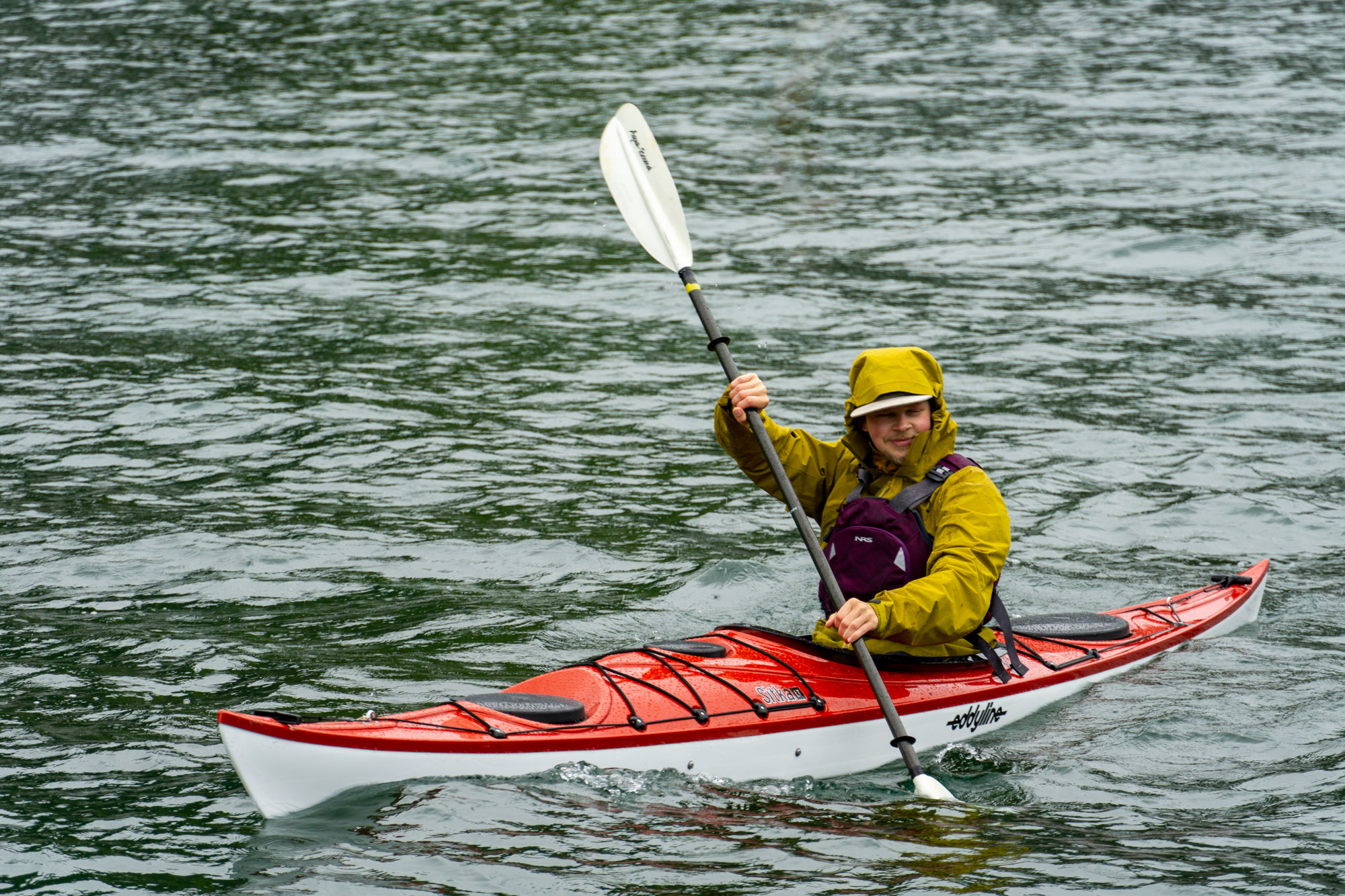
The Best Kayaks of 2025
Kayaks are the original all-terrain vehicles, and we tested the best from Old Town, Wilderness Systems, Eddyline, and more!











